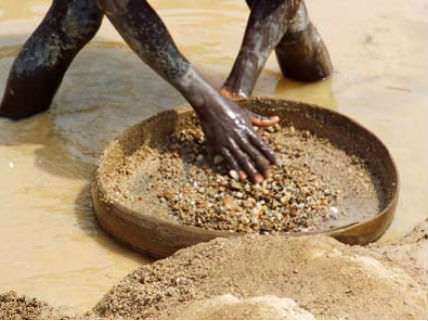Dodd-Frank at 5: How Financial Reform Led to Bloodshed in the Congo
Everything you think you know about conflict minerals is wrong.

The Dodd-Frank financial reform act turns 5 today. It was signed into law by President Obama on July 21, 2010. In the two years immediately following its passage, violence in the Democratic Republic of the Congo (DRC) nearly tripled.
Think those two things are unrelated? Think again.
According to a working paper from Dominic P. Parker of the University of Wisconsin and Bryan Vadheim of the London School of Economics, there's strong evidence to suggest that "conflict mineral" regulations in Section 1502 of Dodd-Frank directly led to an increase in looting in affected regions of the Congo.
I spoke with Parker about his study. Here's what I found out.
Section 1502 of Dodd-Frank was supposed to make life better for people in the DRC. In the words of Barney Frank, one of the bill's sponsors, reducing the demand for conflict minerals would "cut off funding to people who kill people." To that end, the provision required U.S. companies to report the sources of any tin, tantalum, and tungsten—the so-called 3T metals—used in any of their products. (Technically, gold is also a conflict mineral, but according to the working paper, it's nearly impossible to track and has therefore enjoyed a de facto exemption from the boycott.)
As PriceWaterhouseCooper explains on its website, embargoing 3T metals from the DRC has far-reaching implications for American companies. Practically every electronics product contains some conflict minerals. Tin is even found in the zippers of many apparel items. Thus, in 2010, all these manufacturers suddenly had to find alternative sources for their metal needs.
The result was a drop in demand that caused the DRC's tin, tantalum, and tungsten mines to become much less profitable. Section 1502 succeeded, in other words, at "cut[ting] off funding" to the region's militias. But the militias responded to the change by hurting more innocent people instead of less.
According to Parker, violence increased on two fronts: First, some of the militias in the 3T regions left for greener pastures—in this case, the regions containing gold rather than tin or tungsten mines. They then went to war against the established militias in those places, vying through violence for control of the now-more-lucrative flow of gold.
But other militias saw a different path to replacing their lost income: looting local villages. Indeed, Parker and Vadheim found the incidence of looting increased by nearly threefold in the two years after Dodd-Frank was enacted. As a side-effect, violence against civilians shot up as well.
But cash-strapped militia groups could still generate revenue "by roving—taking civilian assets in unpredictable ways and at unpredictable times, which makes them quite dangerous," Parker tells me. "Our evidence suggests that Dodd-Frank caused militia groups to choose this more violent option."
In economics terms, Parker says, conflict mineral regulations converted many of the DRC's militia groups from "stationary" bandits, which extract taxes from people but otherwise do little harm, into what are known as "roving" bandits.
This, it turns out, is much worse for the people on the ground.
"The roving bandit doesn't have a long-run stake in the economic productivity of a place," Parker says, "so he takes what he can get now with little regard for how his [ransacking and stealing] will affect future productivity."
Meanwhile, stationary bandits have every incentive not to hurt too many people.
For a quintessential example, think of the American mafia. "Because the mafia taxes economic activity, it wants the neighborhood that it controls to be safe and productive," Parker says. "So you get this low-violence situation that will persist as long as the mafia group finds it advantageous to remain stationed in the neighborhood, rather than moving to challenge other [mafia groups] or to loot other neighborhoods."
And in the DRC?
"The militias are like the mafia groups. The mining villages are like the neighborhoods."
Perhaps the most unexpected implication of all this is that, pre–Dodd-Frank, the militias in the DRC were actually serving a beneficial function for the region's inhabitants.
"They were providing security and stability for miners in exchange for a tax on the minerals produced," Parker says. "In a country like the Congo, where official government is so limited in its ability to provide security in remote areas, there is a really important role for the spontaneous emergence of groups that can provide security. And any emergence of a group like that, it requires an incentive. So I do wonder where that incentive will come from if there are international interventions like Dodd-Frank that significantly reduce the value of natural resource endowments."
His concerns turned out to be well-founded.
Not only did violence increase between 2010 and 2012, but various other markers of well-being deteriorated as well. Says Parker: "There's some research that we cite in the paper that argues that Dodd-Frank increased poverty [and] unemployment in these rural mining areas…Dodd-Frank may [also] have caused families to pull their children out of school, because they couldn't afford to send them there anymore."
He even has preliminary evidence showing that infant mortality rates in 3T-mining areas increased after Dodd-Frank's passage. "I don't know of any offsetting gains during the time period that we study," he says.
Ultimately, this is a story about unintended consequences. "It's a cautionary tale about what can go wrong when there's a top-down policy intervention that misunderstands the incentives that the on-the-ground actors face," Parker says. "And you can get a result like this, you can get backfiring, and you can get really nasty consequences."


Show Comments (69)